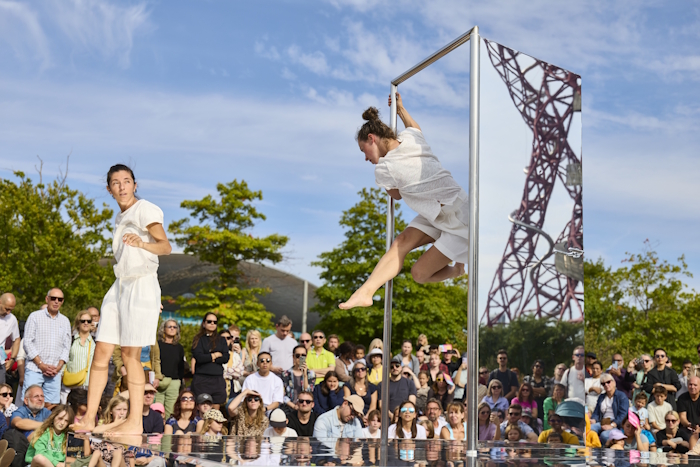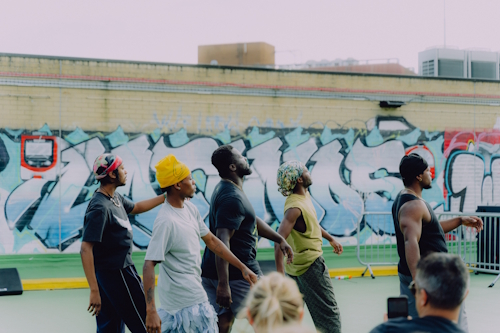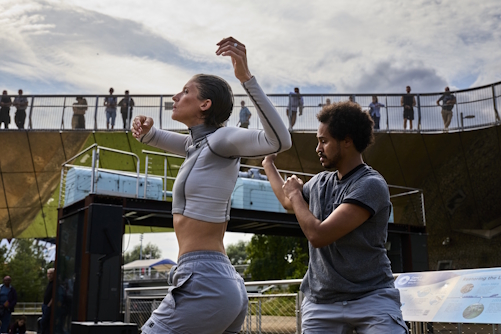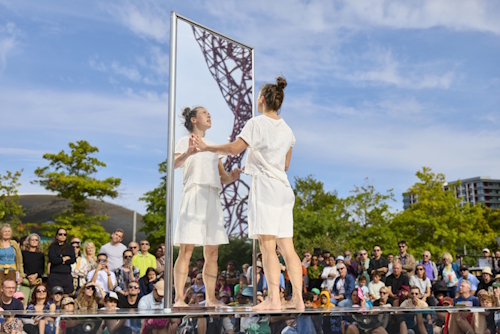Various venues, Stratford, London
September 6, 2025
Curated by artistic director Bradley Hemmings, and held on Saturday September 6, 2025 as part of the Greenwich+Docklands International Festival, Dancing City transformed East London’s squares and rooftops into stages for an afternoon of cross-cultural encounters. From one o’clock until nearly dusk, the programme unfolded not as a single arc but as a patchwork of experiences: at times dazzling, at others tedious.
The day opened with Fragments of Us, a world premiere by Talawa, Fubunation and Sonia Hughes, staged on the rooftop at Stratford. Announced as a celebration of black masculinity in all its possibilities, it began not with solemnity but with play. Performers burst into a mock water pistol battle, drenching each other and teasing the audience before one of them stepped forward to tell a brief, tender love story. His companions leaned against the railings, watching with quiet amusement. It was a disarming beginning: snapshots of joy and affection sketched through street games and confession, a reminder that Dancing City would slip constantly between performance and life.
Later in the afternoon, I slipped into the Sadler’s Wells East foyer for a break. There was an open dance area where children had taken over the stage. A few of them hoisted the soft beanbags meant for seating onto their backs and tore around the floor, turning into a playful parade of fast-moving snails. It was perhaps the best improvisation of the day.
Waterkind, by Swedish duo Land Before Time, unfolded at Carpenters Lock: water against water, a choreography mirrored by the canal itself. The bodies of choreographer-dancers Yared Tilahun Cederlund and Joanna Holewa Chrona rippled and flexed like currents, spines bending in sudden waves, arms quivering as though sensing invisible tides. They seemed less like dancers on land than creatures underwater, moving in dialogue with forces we could not see.
And yet, midway through, a woman beside me leaned over to her friend, laughing as she repeated again and again, “I have no idea!” Half joke, half admission, her words caught the bewilderment of not quite knowing what we were watching.
But above, on the footbridge, a young girl sat cross-legged, peering steadily through the railings. Her stillness offered another insight: that beauty itself can be enough, that you do not need to decode every gesture to feel the pull of water.
From Sweden’s Pontus Lidberg came A Delicate Balance, presented in London as part of the Fire Island Dance Festival’s contribution to Dancing City. Performed with Cuban-born Raul Reinoso, it seemed to hover between fragility and strength. The premise was simple, a glass of water passed and tipped between them, but the execution was full of surprises. Bodies leaned into each other, collapsed and caught again, tracing the knife-edge between trust and exposure. At one point, a child in the audience burst out laughing. “Daddy, he poured water on him!” It was the most guileless of reviews, and perhaps the truest: what we witnessed was both playful and achingly intimate, the comedy of spilt water shading into something deeper about care and risk.
Raquel Galtero’s 360° offered a different kind of balance: endless rotation, a body turned into a compass needle. What might have been mere endurance became instead a meditation on time, childhood and resilience. As she spun, the outer silver-green skirt lifted to reveal flashes of bright inner fabric, like petals glimpsed in mid-bloom. It had the innocent joy of a child’s game, yet carried the weight of memory. And then, the most unscripted of codas. As the performance ended, Galtero’s young daughter ran onstage and hurled herself into her mother’s arms. Forced to bow with the child clinging tightly to her, she transformed the curtain call into a portrait of motherhood itself. The moment recalled the mother in Sadler’s Wells foyer spinning for her daughter’s delight, a reminder that dance, at its core, is always about relation passed from one body to another.
The last work I saw was also the one I most wanted to return to: Yoann Bourgeois’ Passage. A simple revolving door became a stage for endless arrivals and departures, a choreography of thresholds. Who waits on the other side? When it closed, I saw myself. When it opened, I saw you. Between us, the door became both border and playground, a place where intimacy flickered and possibility multiplied. And always, in the glass, the restless world outside was reflected back: dazzling, chaotic, inescapable.
It was a vision both fragile and expansive, as if Bourgeois had distilled the festival’s spirit into a single device. Dancing City itself is such a threshold: between cultures, between theatre and street, between confusion and delight. Watching Passage felt like stepping through that door, from solitude into encounter, from spectacle into relation.
What lingered most from Dancing City was not a single performance but the crossings between them: the trust and fragility of Pontus Lidberg’s A Delicate Balance; the endless spinning of Raquel Galtero’s 360°, its carnival colours caught between childhood play and maternal embrace; the dreamlike threshold of Yoann Bourgeois’ Passage, where every closing door seemed to promise both loss and renewal. Each instant felt self-contained, yet together they mapped a city alive with contradictions.
This multiplicity was not accidental. Greenwich+Docklands is a place where different cultures meet daily, and Dancing City mirrored that porousness. Swedish minimalism brushed against Colombian carnival, French surrealism met British street energy, children’s laughter cut through adult abstraction. Sometimes baffling, sometimes breathtaking, the programme revealed London not as a stage to be decorated, but as a living choreography in itself: messy, diverse, unfinished, and utterly human. Not every transition worked, some shifts between sites felt abrupt, briefly jarring the flow, but the disjointedness felt true to the city’s rhythm, reflecting London’s unpredictable pulse and inviting us to embrace the unresolved.






